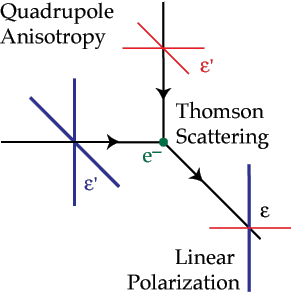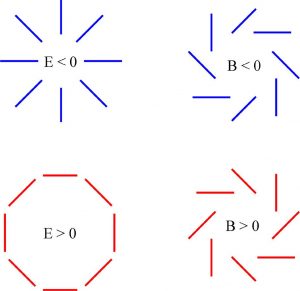Cosmology – early Universe
The birth of the Universe
Big-Bang and CMB
According to current dominant cosmological models, our Universe was born 13.8 billions years ago as a very hot and dense plasma, rapidly expanding: this birth is commonly known as the Big-Bang. During the early ages, this plasma was so dense that light was tightly coupled to it and could not escape from it. When it cooled, the Universe evolved from this very dense, optically thick state to a less dense and cooler state. The first atoms formed, and photons escaped: the Universe became transparent to light, 300 000 years after the Big-Bang.
These photons have since then been traveling through space and time, cooling with the ongoing expansion of the Universe. Observed from Earth today, they form an almost uniform and diffuse signal in the microwave domain: the Cosmic Microwave Background (CMB). The spectrum of the CMB is an almost perfect blackbody with a temperature of 2.7 K, corresponding to the temperature of the initial plasma redshifted by cosmic expansion. The observation and characterisation of the CMB and its features is one of the major domain of interest in modern cosmology.
Inflation
In the 60 and 70, observations of the CMB and of the Universe at large scale have led to huge breakthroughs in our comprehension of cosmic history, but have also brought new questions. Two main characteristics of our Universe are indeed that it is flat – its global geometry shows no curvature in the context of Einstein’s general relativity – and isotropic – its content is the same, regardless the direction of observation.
However, according to “classic” Big-Bang theory, regions of the sky separated by more than a few degrees should never have been in causal contact, so there is no particular reason for these regions to have a similar matter and energy content, or for the CMB to be almost uniform. Moreover, general relativity allows the Universe to have any curvature parameter between -1 (hyperbolic geometry) and 1 (spheric geometry), so why do we measure zero with a high level of confidence, which corresponds to the very particular case of flatness?
To solve these problems, the theory of inflation has been proposed and developed in the late 70-early 80. This theory – or more accurately this group of theories – postulates the existence of a extremely short and rapid phase of expansion at the very beginning of the Universe – lasting less than 10-33 seconds after the Big-Bang! This expansion would explain how regions of the sky could have been in causal contact even if they are far apart today, and also would have flattened the Universe. It would also explain how initial quantum fluctuations have been magnified to give birth to the actual large scale structures, such as galaxies and cluster of galaxies.

Evolution of the Universe since the Big-Bang (Copyright: ESA – C. Carreau)
Primary CMB anisotropies
The CMB is almost uniform, but nevertheless presents small variations in temperature and polarisation. These variations can arise either from phenomenons happening when CMB photons are emitted – primary anisotropies – or from events happening between CMB emission and its detection on Earth – secondary anisotropies (see next section).
Temperature anisotropies
The CMB presents small variations of temperature, 5 orders of magnitude below the blackbody radiation. These variations are due to initial density fluctuations in the early Universe: photons emitted by denser regions of the plasma have more energy – they are “hotter” – than photons emitted by less dense regions. Temperature fluctuations of the CMB have been mapped with a high precision by the Planck satellite.

Map of temperature anisotropies by Planck (ESA)
Polarisation anisotropies
CMB light is polarised and shows polarisation anisotropies, that are even lower than temperature anisotropies. Polarisation anisotropies are created by Thompson scattering in the primordial plasma. The scattering of electromagnetic waves of different intensities (different temperatures) by free electrons produces polarised light. This scattering can only happen when the plasma is thin enough to let light go through it, but there still needs to be free electrons (not recombined into atoms) to scatter the light. Only a small fraction (10%) of the CMB signal is therefore polarised.
Because intensity of light coming from different directions is not the same, photons scattered in different regions of the sky do not result in the same polarisation, creating polarisation anisotropies. This linear polarisation can only be generated if intensity of incoming light varies at 90 degrees, meaning the distribution has a quadrupole pattern.

CMB polarisation through Thomson scattering (Copyright: W. Hu)
These anisotropies find their origins in different physical processes, and cosmologists distinguish two types of resulting polarisation, called E-modes and B-modes.
E-modes
CMB primary E-mode polarisation is created by density fluctuations in the early Universe. These density fluctuations create a velocity gradient: photons are blue-shifted or red-shifted, and their scattering results in a polarised light. These velocity perturbations are scalar, and create symmetric, non-rotational pattern of polarisation over the sky, called E-modes (see figure below). These E-modes have been detected and measured for the first time by the instrument DASI in 2002, and are studied by many experiments. The information content in this polarisation probes the same cosmology and physical processes as temperature anisotropies.
B-modes
If E-modes come from scalar perturbations (density fluctuations), B-modes can only be produced by tensor perturbations, which create a non-symmetric, rotational pattern of polarisation. The only mechanism that could create such perturbations in the early Universe are gravity waves. B-mode polarisation therefore probes a new, different early Universe physics than E-mode polarisation.

E and B-modes pattern
Looking for inflation
Inflation is thought to have produced gravitational waves in the early Universe, and this would be the only mechanism that could have produced gravitational waves at this stage of Universe history with (potentially) large enough intensity to be measured. The production of gravitational waves by an inflationary process is also the only one that could have generated tensor perturbations, necessary for producing primordial B-modes. The detection of primordial B-modes would be a strong evidence for the existence of inflation. The search for these modes is therefore central for our comprehension of the Universe. The intensity of primordial B-modes is related to the energy scale of the inflationary process, and depends on the intensity of tensor perturbations compared to scalar perturbations. The ratio between these two quantities, called the tensor-to-scalar ratio and usually denoted as r, is one of the crucial parameters that would give us information about inflation, and is what we are trying to measure through B-modes.
However, primordial B-modes are several orders of magnitude below temperature anisotropies and E-modes, and their detection is even harder because of secondary anisotropies affecting CMB signal between its emission and its detection on Earth.

